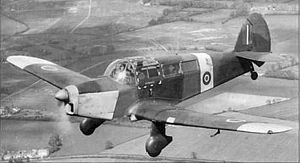Percival Proctor
| Percival Proctor | |
|---|---|
 |
|
| RAF Percival Proctor I | |
| Role | Radio trainer/communications aircraft |
| Manufacturer | Percival Aircraft Limited |
| Designer | Edgar Percival |
| First flight | 8 October 1939 |
| Retired | 1955 |
| Primary users |
RAF Fleet Air Arm |
| Number built | 1,143 |
| Developed from | Percival Vega Gull |
The Percival Proctor was a British radio trainer and communications aircraft of the Second World War. The Proctor was a single-engined, low-wing monoplane with seating for three or four, depending on the model.
The Proctor was developed from the Percival Vega Gull in response to Air Ministry Specification 20/38 for a radio trainer and communications aircraft. To meet the requirement, the aircraft based on the Vega Gull had larger rear cabin windows and the fuselage was six inches longer. Modifications were made to the seats to enable the crew to wear parachutes, and other changes to enable a military radio and other equipment to be fitted. In early 1939 an order was placed for 247 aircraft to meet operational requirement OR.65.
The prototype aircraft, serial number P5998, first flew on 8 October 1939 from Luton Airport. and the type was put into production for the RAF and Fleet Air Arm. The prototype was tested as an emergency bomber during 1940 but this idea was abandoned as the invasion threat receded. Although the first 222 aircraft were built by Percival at Luton, most of the remaining aircraft were built by F. Hills & Sons of Trafford Park near Manchester. They built 812 Proctors of several marks between 1941 and 1945, assembling most of the aircraft at Barton Aerodrome.
It should be noted that, whilst the very early Proctors (Mks I to III.) followed very closely the last incarnation of the superb Vega Gull, and consequently, most of its performance, later versions became much heavier and less aerodynamic, with inevitable detrimental effects upon their performance. The later marks of Proctor, whilst looking broadly similar, were in fact a complete redesign of the aircraft and were much enlarged, heavier and even less efficient. Flight performance was poor. There were later plans to fit them with the 250 hp Queen 30 and larger airscrew, but only one trial aircraft was so fitted as the all-metal Prentice was being developed to replace the Proctor, utilising the Queen 30 etc. Interestingly, the Prentice itself proved to be a very poor aircraft (Even worse than the late Proctors.) and served in the RAF for only a handful of years before withdrawal as it was deemed unsatisfactory. The remaining Proctors in use soldiered-on after Service use in private hands until the 1960s. At this point, owing to concerns about the degradation of glued joints in their wooden airframes, they were all grounded. Several surviving Proctors have been rebuilt with modern adhesives and should be returned to the air shortly. Early Proctors still make good light aircraft, as they combine the Vegas attributes of Long-range, speed and load-carrying ability. Notably, all Proctors inherited the Vega Gulls feature of wing-folding.
...
Wikipedia
